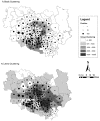Racial/Ethnic Residential Segregation and the First Wave of SARS-CoV-2 Infection Rates: A Spatial Analysis of Four U.S. Cities
- PMID: 38603057
- PMCID: PMC8404417
- DOI: 10.1177/07311214211041967
Racial/Ethnic Residential Segregation and the First Wave of SARS-CoV-2 Infection Rates: A Spatial Analysis of Four U.S. Cities
Abstract
Previous research has linked racial/ethnic residential segregation to a number of poor health conditions, including infectious disease. Here, we examine how racial/ethnic residential segregation is related to the novel coronavirus, SARS-CoV-2. We examine infection rates by zip code level segregation in four major cities across the U.S.: New York City, Chicago, Houston, and San Diego. We also include a number of area-level Census variables in order to analyze how other factors may help account for the infection rate. We find that both Black and Latino residential clustering are significantly and positively related to a higher SARS-CoV-2 infection rate across all four cities, and that this effect is strong even when accounting for a number of other social conditions and factors that are salient to the transmission of infectious disease. As a result, we argue that neighborhood-level racial/ethnic patterning may serve as an important structural mechanism for disparities in SARS-CoV-2 infection.
Keywords: COVID-19; SARS-CoV-2; health inequality; race/ethnicity; residential segregation.
© The Author(s) 2021.
Conflict of interest statement
Declaration of Conflicting Interests: The author(s) declared no potential conflicts of interest with respect to the research, authorship, and/or publication of this article.
Figures




Similar articles
-
Race/Ethnicity and Geographic Access to Urban Trauma Care.JAMA Netw Open. 2019 Mar 1;2(3):e190138. doi: 10.1001/jamanetworkopen.2019.0138. JAMA Netw Open. 2019. PMID: 30848804 Free PMC article.
-
Racial disparities in low birthweight and the contribution of residential segregation: a multilevel analysis.Soc Sci Med. 2006 Dec;63(12):3013-29. doi: 10.1016/j.socscimed.2006.08.017. Epub 2006 Sep 25. Soc Sci Med. 2006. PMID: 16996670
-
Mortgage Discrimination and Racial/Ethnic Concentration Are Associated with Same-Race/Ethnicity Partnering among People Who Inject Drugs in 19 US Cities.J Urban Health. 2020 Feb;97(1):88-104. doi: 10.1007/s11524-019-00405-w. J Urban Health. 2020. PMID: 31933055 Free PMC article.
-
Racial/Ethnic Residential Segregation, Obesity, and Diabetes Mellitus.Curr Diab Rep. 2016 Nov;16(11):108. doi: 10.1007/s11892-016-0800-0. Curr Diab Rep. 2016. PMID: 27664041 Review.
-
Authors' response: Occupation and SARS-CoV-2 infection risk among workers during the first pandemic wave in Germany: potential for bias.Scand J Work Environ Health. 2022 Sep 1;48(7):588-590. doi: 10.5271/sjweh.4061. Epub 2022 Sep 25. Scand J Work Environ Health. 2022. PMID: 36153787 Free PMC article. Review.
Cited by
-
Simulating desegregation through affordable housing development: an environmental health impact assessment of Connecticut zoning law.medRxiv [Preprint]. 2024 Feb 14:2024.02.13.24302645. doi: 10.1101/2024.02.13.24302645. medRxiv. 2024. Update in: Health Place. 2024 Jul;88:103277. doi: 10.1016/j.healthplace.2024.103277. PMID: 38405953 Free PMC article. Updated. Preprint.
-
The cost of social vulnerability: an integrative conceptual framework and model for assessing financial risks in natural disaster management.Nat Hazards (Dordr). 2022;114(1):691-712. doi: 10.1007/s11069-022-05408-6. Epub 2022 May 26. Nat Hazards (Dordr). 2022. PMID: 35637837 Free PMC article.
-
Contextualizing Inequities in COVID Vaccination Trends Among Project REFOCUS Pilot Sites: Racism-Related Determinants of Health.Ethn Dis. 2024 May 27;34(1):1-7. doi: 10.18865/ed.34.1.1. eCollection 2024 Jan. Ethn Dis. 2024. PMID: 38854790 Free PMC article.
-
Association between racial residential segregation and walkability in 745 U.S. cities.Health Place. 2023 Nov;84:103114. doi: 10.1016/j.healthplace.2023.103114. Epub 2023 Sep 27. Health Place. 2023. PMID: 37774640 Free PMC article.
-
Simulating desegregation through affordable housing development: An environmental health impact assessment of Connecticut zoning law.Health Place. 2024 Jul;88:103277. doi: 10.1016/j.healthplace.2024.103277. Epub 2024 May 22. Health Place. 2024. PMID: 38781859
References
-
- Acevedo-Garcia Dolores. 2000. “Residential Segregation and the Epidemiology of Infectious Diseases.” Social Science & Medicine 51(8):1143–61. - PubMed
-
- Adimora Adaora A., Schoenbach Victor J. 2005. “Social Context, Sexual Networks, and Racial Disparities in Rates of Sexually Transmitted Infections.” Journal of Infectious Diseases 191(1):S115–22. - PubMed
-
- Alba Richard, Logan John R. 1993. “Minority Proximity to Whites in Suburbs: An Individual-level Analysis of Segregation.” American Journal of Sociology 98(6):1388–427.
LinkOut - more resources
Full Text Sources
Research Materials
Miscellaneous
